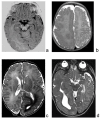Hemispherotomy in Infants with Hemimegalencephaly: Long-Term Seizure and Developmental Outcome in Early Treated Patients
- PMID: 36672056
- PMCID: PMC9856354
- DOI: 10.3390/brainsci13010073
Hemispherotomy in Infants with Hemimegalencephaly: Long-Term Seizure and Developmental Outcome in Early Treated Patients
Abstract
Hemimegalencephaly (HME) is a rare brain congenital malformation, consisting in altered neuronal migration and proliferation within one hemisphere, which is responsible for early onset drug-resistant epilepsy. Hemispherotomy is an effective treatment option for patients with HME and drug-resistant epilepsy. Surgical outcome may be variable among different surgical series, and the long-term neuropsychological trajectory has been rarely defined using a standardized neurocognitive test. We report the epileptological and neuropsychological long-term outcomes of four consecutive HME patients, operated on before the age of three years. All patients were seizure-free and drug-free, and the minimum follow-up duration was of five years. Despite the excellent post-surgical seizure outcome, the long-term developmental outcome is quite variable between patients, ranging from mild to severe intellectual disabilities. Patients showed improvement mainly in communication skills, while visuo-perceptive and coordination abilities were more impaired. Epileptological outcome seems to be improved in early treated patients; however, neuropsychological outcome in HME patients may be highly variable despite early surgery.
Keywords: developmental outcome; epilepsy surgery; hemimegalencephaly; hemispherotomy.
Conflict of interest statement
The authors declare no conflict of interest.
Figures



References
LinkOut - more resources
Full Text Sources

